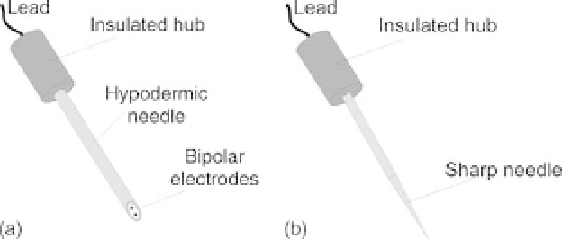Biomedical Engineering Reference
In-Depth Information
The most common type of biopotential electrode is the silver/silver chloride electrode
(Ag/AgCl), which is formed by electrochemically depositing a very thin layer of silver chlo-
ride onto a silver electrode (Figure 10.6b). These electrodes are recessed from the surface of
the skin and imbedded in foam that has been soaked with an electrolyte paste to provide
good electrical contact with the skin. The electrolyte-saturated foam is also known to reduce
motion artifacts that could be produced, for example, during stress testing when the layer
of the skin moves relative to the surface of the Ag/AgCl electrode. This motion artifact
could cause large interference in the recorded biopotential and, in extreme cases, could
severely degrade the measurement.
10.2.3 EMG Electrodes
A number of different types of biopotential electrodes are used in recording electromyo-
graphic (EMG) signals from different muscles in the body. The shape and size of the
recorded EMG signals depend on the electrical property of these electrodes and the record-
ing location. For noninvasive recordings, proper skin preparation, which normally involves
cleansing the skin with alcohol or the application of a small amount of an electrolyte paste,
helps to minimize the impedance of the skin-electrode interface and improve the quality of
the recorded signal considerably. The most common electrodes used for surface EMG
recording and nerve conduction studies are circular discs, about 1 cm in diameter, that
are made of silver or platinum.
For direct recording of electrical signals from nerves and muscle fibers, a variety of per-
cutaneous needle electrodes are available, as illustrated in Figure 10.7. The most common
type of needle electrode is the concentric bipolar electrode shown in Figure 10.7a. This
electrode is made from thin metallic wires encased inside a larger canula or hypodermic
needle. The two wires serve as the recording and reference electrodes. Another type of
percutaneous EMG electrode is the unipolar needle electrode (Figure 10.7b). This electrode
is made of a thin wire that is mostly insulated by a thin layer of Teflon, except about
300
m near the distal tip. Unlike a bipolar electrode, this electrode requires a second
unipolar reference electrode to form a closed electrical circuit. The second recording elec-
trode is normally placed either adjacent to the recording electrode or attached to the surface
of the skin.
m
FIGURE 10.7
Intramascular biopotential electrodes: (a) bipolar and (b) unipolar configuration.


